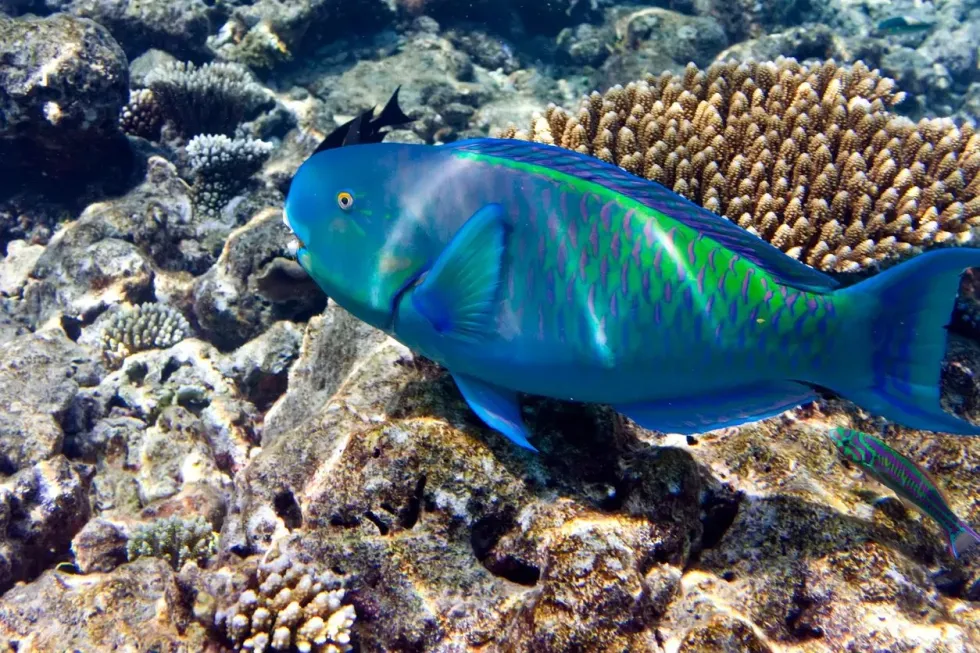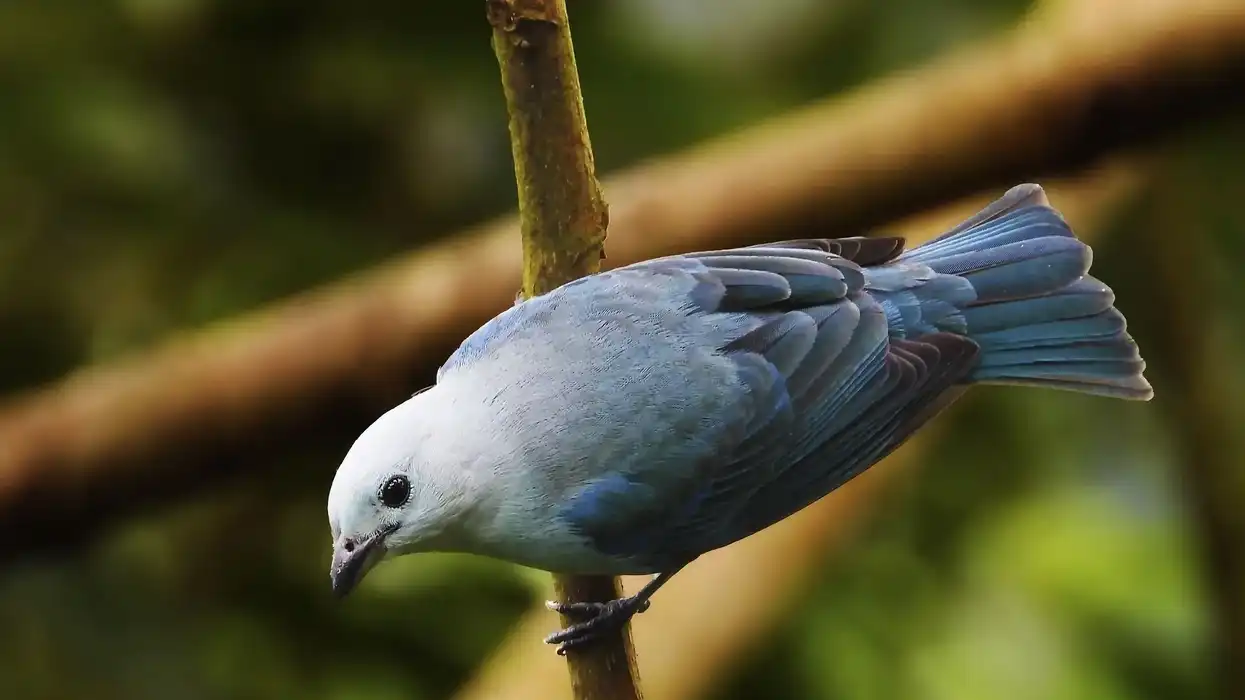The blue parrotfish (Scarus coeruleus) is a species of parrotfish found in the coral reefs, usually feeding on them. Unlike other species of fishes, these creatures are rarely kept as a pet in the aquariums because of their weird behavior and unusual size.
They spend most of their time searching for food as they only feed on the coral reefs and other creatures on the algae.
The Scarus coeruleus is named the blue parrotfish because of its royal blue color, which is easily identified among the various marine creatures. Although the Scarus coeruleus is not kept as a pet in an aquarium, it is fished to eat as humans like to consume them.
The unique feature of these marine species of fish is that they can change themselves to males or females anytime in their lifetime. These fused teeth marine creatures can also give birth without breeding together.
Usually, the males and females breed together, but it can also be possible for females to lay eggs without performing the breeding process.
It is illegal to catch parrotfish for harvesting purposes in Florida. Parrotfish under 12 in (30 cm) in length can be caught with nets or slurp guns and kept alive for aquariums.
Here on our page, we have lots of amazing facts about blue parrotfish that everyone will enjoy. Let's look at these interesting facts; if you like these, do read our articles on the golden tench and the kelp bass.
Blue Parrotfish Interesting Facts
What type of animal are blue parrotfish?
The blue parrotfish (Scarus coeruleus) is a large size beak-like species of parrotfish of the genus Scarus. They are found in the Western Atlantic Ocean distribution and the Caribbean Sea.
What class of animal does a blue parrotfish belong to?
The Scarus coeruleus is a species of the Arthropod phylum. They belong to the class of Actinopterygii with the genus of Scarus and are of the family Scaridae.
How many blue parrotfish are there in the world?
The total population of blue parrotfish (Scarus coeruleus) is unknown, but they are rapidly growing as they are safe, according to the IUCN Red List.
Where do blue parrotfish live?
The natural habitat of these beak-like and fused teeth marine blue parrotfish is the Western Atlantic Ocean, Caribbean Sea, and Bermuda, the Bahamas. They mainly find their habitat near their food in the water column on the coral reefs near the algae plants and sandbeds.
What is a blue parrotfish's habitat?
These species of parrotfish or the Scarus coeruleus are found in the tropical and sub-tropical regions in the water column on the coral reef. They live in the depth of water and close to the algae plants, so they can feed on them easily.
Who do blue parrotfish live with?
Like the other species of fishes, the blue parrotfish also live together in groups and schools. They usually form a group of 40 fish or more, where the male is the leader, and all the other fish in the groups are females.
When the male leader dies, one of the female fish undergoes the change and becomes the male fish and then leads the group. The usual behavior of these species is to spend their whole lifetime either laying eggs or in search of food to eat.
How long do a blue parrotfish live?
The life cycle of these Western Atlantic-Caribbean fish is very long. They can easily live up to 20 years of age if they continue to get their diet and avoid fishers.
How do they reproduce?
The mating season begins in June, where the mature males and females who are above two to four years of age come together in a group where they form pairs. After the mating process is finished, the female releases the eggs into the water column on the rocks and sand.
The eggs hatch after a day, and the young fry starts feeding after three days.
What is their conservation status?
The conservation status of the blue parrotfish is in the Least Concern category by the IUCN Red List. This means that this fish is safe in the world. Although these fish are the targets of fishermen, their growth is intact, so they are safe in this world.
Blue Parrotfish Fun Facts
What do blue parrotfish look like?
As the name suggests, the blue parrotfish are blue. When the fish are young, they have a yellow spot on their head, but as they grow, the yellow spot becomes an intense blue, and their whole body length from head to tail is found in blue color.
The fish have beak-like jaws because of their fused teeth used for eating green algae from the rocks; this is why they are called parrotfish.
How cute are they?
The blue parrotfish has a cute appearance which attracts many people. When the blue parrotfish fry is young, its unique yellow color looks very cute and different from other fish species.
How do they communicate?
Like all fish, the blue parrotfish can also communicate with the color, sound, motions, and scents. Using this, they can navigate and come to know which fish is ready to mate. The blue parrotfish also hide their scents so that their predators do not find them.
How big are blue parrotfish?
The average size of a blue parrotfish can be between 12-30 in (30-75 cm) and the maximum length is up to 4 ft (1.2 m). They are large fish, and they are two to five times larger than crustaceans such as crabs and krill.
How fast can a blue parrotfish swim?
The blue parrotfishes are fast swimmers in the marine world. These creatures can swim up to a speed of 3.2 times their total length per second.
How much do a blue parrotfish weigh?
The average weight of blue parrotfishes can be around 20 lb (9 kg). They are one of the large and heavy fish in the marine world.
What are the male and female names of the species?
The adult does not have a specific name for the females and males. They are simply referred to as male blue parrotfish and female blue parrotfish.
What would you call a baby blue parrotfish?
The baby blue parrotfish is also known as little fry. The youngs are laid on the water column when they are eggs. The blue parrotfish are called young till they are above the age of three and are ready to mate.
What do they eat?
The normal diet of the blue parrotfishes includes the coral reefs and the creatures on them. They usually feed on the algae plants with their beak and are also known to eat dead coral reefs.
These creatures spend almost their whole life in completing their diet and are found on the rocks and sands near the corals. They sometimes eat other fish that can fit into their mouths.
Are they poisonous?
As these creatures feed on the coral life, they can contain biotoxins – a fish poisoning substance that can be deadly. However, if you properly cook and clean them, they are a great-tasting fish to eat. They are popularly served in Jamaica.
Would they make a good pet?
These parrotfishes can be kept as a pet, but it is a very hard business as their large size, and unusual behavior are hard to handle. The other reason is that they cannot be kept with the other species, especially in small tanks. It is better to keep them as a pet only if the owner is experienced.
Did you know...
These species of parrotfishes have the unique ability to convert a ton of corals into the sand in just one year.
Are blue parrotfish endangered?
No, the blue parrotfishes are not endangered in the world. However, they are on the path to being listed as Endangered as many fishers hunt them.
Humans are also destroying the coral reef habitat that houses algae, which is the main diet of these species. Fishing, pollution, climate change, and destruction of coral reefs are some of the major threats.
What do parrotfish get eaten by?
The main predators of the parrotfishes are the reef shark, eels, and similar marine life. Sharks and large bony fish can also eat these creatures.
Here at Kidadl, we have carefully created lots of interesting family-friendly animal facts for everyone to discover! Learn more about some other fish from our false catshark facts and catshark facts pages.
You can even occupy yourself at home by coloring in one of our free printable blue parrotfish coloring pages.










